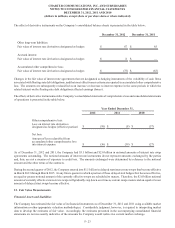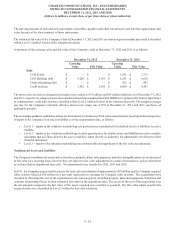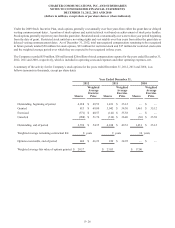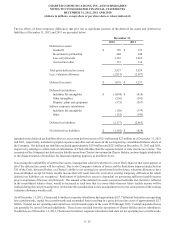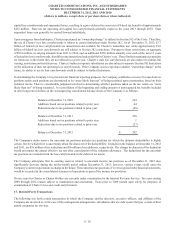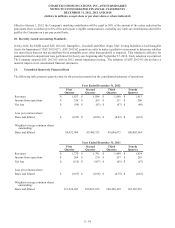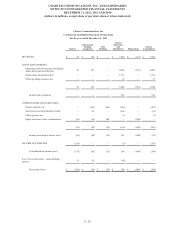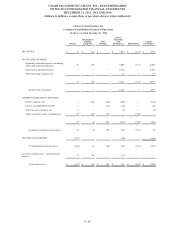Charter 2012 Annual Report Download - page 108
Download and view the complete annual report
Please find page 108 of the 2012 Charter annual report below. You can navigate through the pages in the report by either clicking on the pages listed below, or by using the keyword search tool below to find specific information within the annual report.
CHARTER COMMUNICATIONS, INC. AND SUBSIDIARIES
NOTES TO CONSOLIDATED FINANCIAL STATEMENTS
DECEMBER 31, 2012, 2011 AND 2010
(dollars in millions, except share or per share data or where indicated)
F- 33
received distributions of approximately $168 million pursuant to the Plan); and (ii) R2 Investments, LDC (“R2 Investments”) (a
former equity interest holder in Charter). The appeals by LDT and R2 Investments were denied by the District Court for the
Southern District of New York in March 2011. On August 31, 2012, the 2nd Circuit Court of Appeals unanimously affirmed the
district court's decision holding that R2 Investments and LDT's appeals are equitably moot. Thereafter, R2 Investments and LDT
sought a rehearing en banc with the 2nd Circuit which was denied. On January 10, 2013, R2 Investments and LDT filed a petition
for a writ of certiorari with the United States Supreme Court, asking that court to review the 2nd Circuit's decision claiming there
is a split among the circuit Courts regarding the equitable mootness principle that the Supreme Court should resolve. The Company
continues to vigorously contest this matter although it cannot predict the ultimate outcome of this lawsuit nor can it reasonably
estimate a range of possible loss.
The Company is also a defendant or co-defendant in several lawsuits claiming infringement of various patents relating to various
aspects of its businesses. Other industry participants are also defendants in certain of these cases. In the event that a court ultimately
determines that the Company infringes on any intellectual property rights, the Company may be subject to substantial damages
and/or an injunction that could require the Company or its vendors to modify certain products and services the Company offers
to its subscribers, as well as negotiate royalty or license agreements with respect to the patents at issue. While the Company
believes the lawsuits are without merit and intends to defend the actions vigorously, no assurance can be given that any adverse
outcome would not be material to the Company's consolidated financial condition, results of operations, or liquidity. The Company
cannot predict the outcome of any such claims nor can it reasonably estimate a range of possible loss.
The Company is party to lawsuits and claims that arise in the ordinary course of conducting its business, including lawsuits claiming
violation of anti-trust laws and violation of wage and hour laws. The ultimate outcome of these other legal matters pending against
the Company cannot be predicted, and although such lawsuits and claims are not expected individually to have a material adverse
effect on the Company’s consolidated financial condition, results of operations or liquidity, such lawsuits could have, in the
aggregate, a material adverse effect on the Company’s consolidated financial condition, results of operations or liquidity. Whether
or not the Company ultimately prevails in any particular lawsuit or claim, litigation can be time consuming and costly and injure
the Company's reputation.
Regulation in the Cable Industry
The operation of a cable system is extensively regulated by the Federal Communications Commission (“FCC”), some state
governments and most local governments. The FCC has the authority to enforce its regulations through the imposition of substantial
fines, the issuance of cease and desist orders and/or the imposition of other administrative sanctions, such as the revocation of
FCC licenses needed to operate certain transmission facilities used in connection with cable operations. The Telecommunications
Act of 1996 altered the regulatory structure governing the nation’s communications providers. It removed barriers to competition
in both the cable television market and the telephone market. Among other things, it reduced the scope of cable rate regulation
and encouraged additional competition in the video programming industry by allowing telephone companies to provide video
programming in their own telephone service areas. Future legislative and regulatory changes could adversely affect the Company’s
operations.
19. Employee Benefit Plan
The Company’s employees may participate in the Charter Communications, Inc. 401(k) Plan. Employees that qualify for
participation can contribute up to 50% of their salary, on a pre-tax basis, subject to a maximum contribution limit as determined
by the Internal Revenue Service. Each payroll period, the Company will contribute to the 401(k) Plan the total amount of the
salary reduction the employee elects to defer between 1% and 50%. The Company’s matching contribution is discretionary with
the intent that any contribution be based on performance metrics used in its other bonus and incentive plans. The discretionary
performance contribution is made on an annual basis (instead of on a per pay period basis). Each participant who makes before-
tax contributions and is employed on the last day of the fiscal year receives a portion of the discretionary performance contribution,
if any, on a pro rata basis. The Company divides each participant’s before-tax contributions for the year (up to 5% of eligible
earnings, excluding catch-up contributions) by the total employee contributions (up to 5% of eligible earnings, excluding catch-
up contributions) for the year to determine each participant’s share of any discretionary performance contribution. The Company
made contributions to the 401(k) plan totaling $6 million and $7 million for the years ended December 31, 2011 and 2010,
respectively, and expects to make contributions to the 401(k) plan totaling $8 million for the year ended December 31, 2012.


